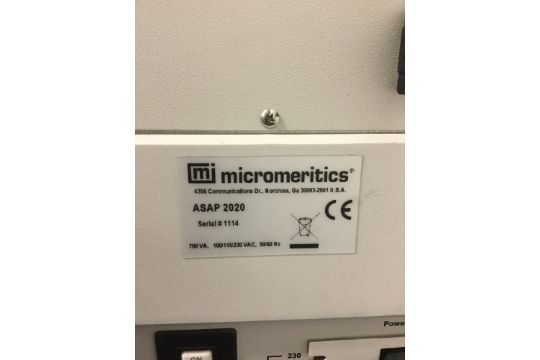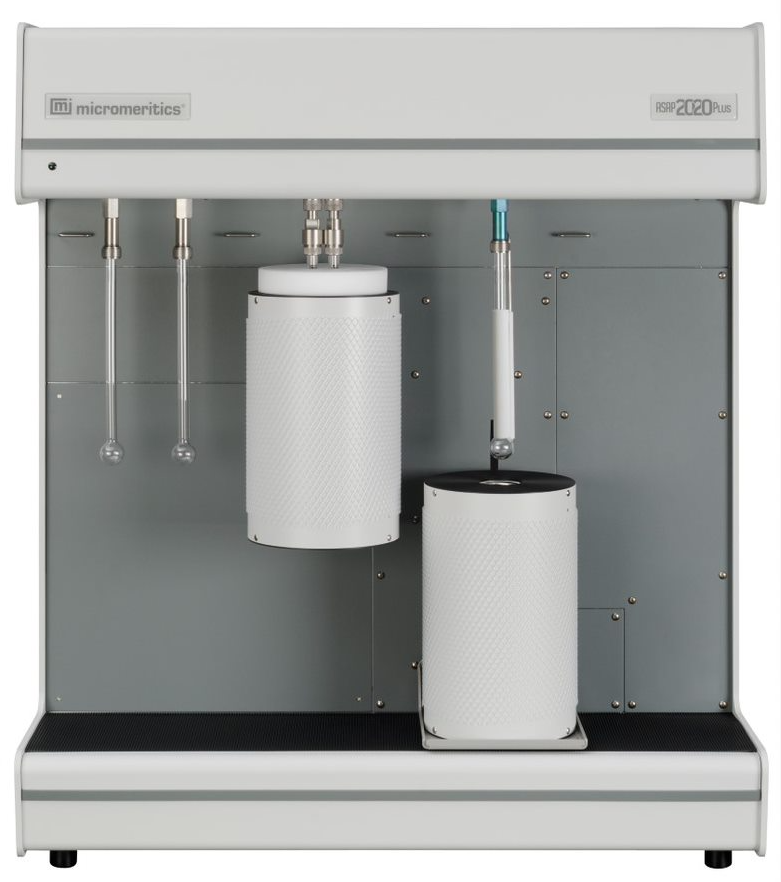Description


Micromeritics’ ASAP 2020 Accelerated Surface Area and Porosimetry analyzer uses the gas sorption technique to generate high-quality data for research and quality control applications. Available options include the micropore option, the high-vac option, and the chemisorption option, which uses the static volumetric technique to determine the percent metal dispersion, active metal surface area, size of active particles, and surface acidity of catalyst materials. Data obtained by an ASAP 2020 analyzer are used to achieve efficiency, safety, quality, and profitability in any modern materials-oriented work, and can be used by scientists with confidence and assurance.
Uses of the ASAP 2020
The ASAP 2020 is used to monitor catalysts converting a stream of feedstock chemicals into a product, activated carbon used for the recovery of precious metals from a mining process solution, a pharmaceutical tablet as it undergoes dissolution and absorption at just the right dosing rate, and production of ceramics made from an exacting combination of finely powdered raw materials. Micromeritcs’ staff of scientists and engineers can help you determine how the ASAP 2020 can be used for your application.
Micromeritics’ ASAP 2020 Plus integrates a variety of automated gas sorption techniques into a single, research-grade, table-top instrument. The system is designed to provide high-quality surface area, porosity, and chemisorption data to materials analysis laboratories. The ASAP 2020 Plus is configurable with many optional accessories and features in a platform that can be expanded with. Micromeritics’ ASAP 2020 Accelerated Surface Area and Porosimetry analyzer uses the gas sorption technique to generate high-quality data for research and quality control applications. Different parameters related to these two properties can be determined by using special gas adsorption measuring equipment, together with the corresponding software which can perform analyses according to different adsorption theories (e.g. The Brunauer, Emmet and Teller theory, and the Barrett, Joyner and Halenda theory). Micromeritics’ staff of scientists can help you determine how the ASAP 2020 can be used for your application. New ASAP 2020 version 3.00 software provides options specifically designed to help fuel cell and hydrogen storage researchers.
Features


- Two Independent vacuum systems that allow preparation and analysis to proceed concurrently
- Oil-free “dry” vacuum option to prevent oil contamination
- Two-station intelligent degas system for fully automated degassing with controlled heating time profiles
- long-duration cryogen system for unattended analyses
- Twelve gas inlets that are automatically selectable to allow for automated selection of pretreatment, backfill, and analysis gases, and the ability to connect to a mass spectrometer
Analysis Technique
The basics of the analytical technique are simple; a sample contained in an evacuated sample tube is cooled (typically) to cryogenic temperature, then is exposed to analysis gas at a series of precisely controlled pressures. With each incremental pressure increase, the number of gas molecules adsorbed on the surface increases. The pressure at which adsorption equilibrium occurs is measured and the universal gas law is applied to determine the quantity of gas adsorbed.
As adsorption proceeds, the thickness of the adsorbed film increases. Any micropores in the surface are quickly filled, then the free surface becomes completely covered, and finally larger pores are filled. The process may continue to the point of bulk condensation of the analysis gas. Then, the desorption process may begin in which pressure systematically is reduced resulting in liberation of the adsorbed molecules. As with the adsorption process, the changing quantity of gas on the solid surface is quantified. These two sets of data describe the adsorption and desorption isotherms. Analysis of the isotherms yields information about the surface characteristics of the material.
Micromeritics Asap 2020 Software Free
Specification
Micromeritics Asap 2020 Software Review
| Pressure Measurement: | Range: 0 to 950 mmHg Resolution:
Includes nonlinearity, hysteresis, and nonrepeatability. Transducer manufacturer’s specifications.
|
| System Capacity: | Sample Preparation: 2 integrated degas ports Analysis: 1 sample port and 1 saturation pressure tube Up to 2 complete analysis units can be independently controlled by 1 computer |
| Vacuum System: | Degas: Either two-stage, oil sealed, mechanical vacuum pump, 5 x 10-3 mmHg ultimate vacuum or high vacuum system ultimate vacuum <10-8 mbar Analysis – Nitrogen system: two stage, oil sealed mechanical vacuum pump, 5 x 10-3 mmHg ultimate vacuum. Multigas and Micropore: High vac system, ultimate <10-8 mbar. |
| Degas System: | Temperature Range: Ambient to 450 ºC(Programmable) Temperature Selection: Digitally set, 1 ºC increments Accuracy: Deviation less than +/- 10 ºC of set point at thermocouple Backfill Gas: User-selectable, typically nitrogen or helium |
| Cryogen System: | Patented Isothermal Jackets effectively maintain cryogen level constant on sample tube and P0 tube during analysis as evaporation of cryogen occurs. Capacity: 3-Liter Dewar, which provides up to 72 hours of unattended analysis. Analysis Time: Unlimited. Cryogen Dewars may be refilled without affecting the accuracy of results |
| Sample Size: | Sample tubes are available for various size pellets, cores, and powders. Sample tube stems are 1/2-in.(1.27-cm) OD with 9-cm3 bulbs, 1/4-in. (0.635-cm) or 3/8-in. (0.953-cm) OD stems with 9-cm3 bulbs. Special tubes can be designed. |
| Electrical: | Voltage: 100, 115, 230 VAC +/-10% Frequency: 50/60 Hz Power: 700 VA, operating (maximum) |
| Physical: | Height: 99 cm (39 in.) Width: 85 cm (33.5 in.) Depth: 61 cm (24 in.) Weight: 115 kg (250 lbs) |
| Miscellaneous: | ISO 9001 manufacturer , CE certified |